This post provides a summary of some of the essential physical parameters of Comet 67P/Churyumov-Gerasimenko, as measured by Rosetta ahead of and since its 6 August rendezvous. This is an on-going process and the numbers will be updated as newer data are obtained, analysed, and made available.
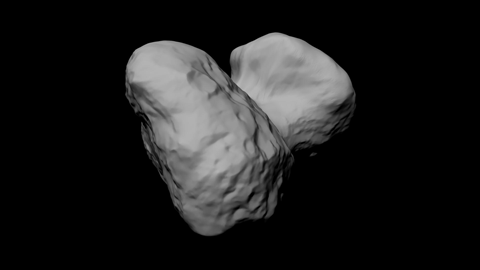
Shape model of 67P/C-G. Credits: ESA/Rosetta/MPS for OSIRIS Team MPS/UPD/LAM/IAA/SSO/INTA/UPM/DASP/IDA
One of the key things is the so-called “shape model”, meaning a 3D model of the comet based on images from the OSIRIS and NAVCAM cameras. In a previous post we showed a render of one of the first shape models derived from OSIRIS data. Here we are releasing a more recent OSIRIS shape model in .wrl and .obj format, suitable for loading into 3D graphics applications (click the links to download).
A render of this shape model is shown at the top of this page, while the image below shows a pair of NAVCAM images to illustrate the sizes.
Because roughly 30% of the ‘dark side’ of 67P/C-G has not been resolved and analysed fully yet, the shape model is very incomplete over those regions. As a result, some of the derived parameters for the comet are only best estimates at present. These include the volume and the global density, the latter depending on the mass and the volume.
The table below summarises the approximate dimensions of 67P/C-G and other known parameters derived from observations made by Rosetta, with the instrument with which the measurement was made also indicated. Links are provided to earlier posts where some of these numbers have been previously presented.
Again, these values are preliminary and will likely change as the mission progresses and more data are available, and as the comet itself changes as it moves closer to the Sun. Similarly, other parameters such as the albedo of the comet will be added to this table, as they are made available by the instrument science teams.
| Dimensions (small lobe) | 2.5 x 2.5 x 2.0 km | OSIRIS |
| Dimensions (large lobe) | 4.1 x 3.2 x 1.3 km | OSIRIS |
| Rotation | 12.4043 hours | OSIRIS |
| Spin axis | Right ascension: 69 degrees; Declination: 64 degrees | OSIRIS |
| Mass | 10^13 kg | RSI |
| Volume | 25 km^3 | OSIRIS |
| Density | 0.4 g/cm^3 | RSI / OSIRIS |
| Water vapour production rate | 300 ml/sec (Jun 2014); 1–5 l/sec (Jul-Aug 2014) | MIRO |
| Surface temperature | 205–230K (Jul-Aug 2014) | VIRTIS |
| Subsurface temperature | 30–160K (Aug 2014) | MIRO |
| Gases detected | Water, carbon monoxide, carbon dioxide, ammonia, methane, methanol | ROSINA |
| Dust grains | A few tens of microns to a few hundreds of microns | COSIMA (detections also by GIADA) |


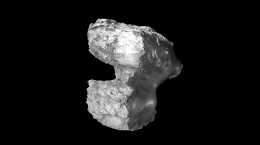
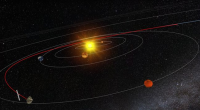
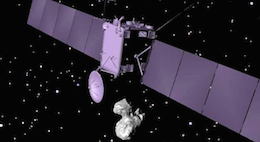


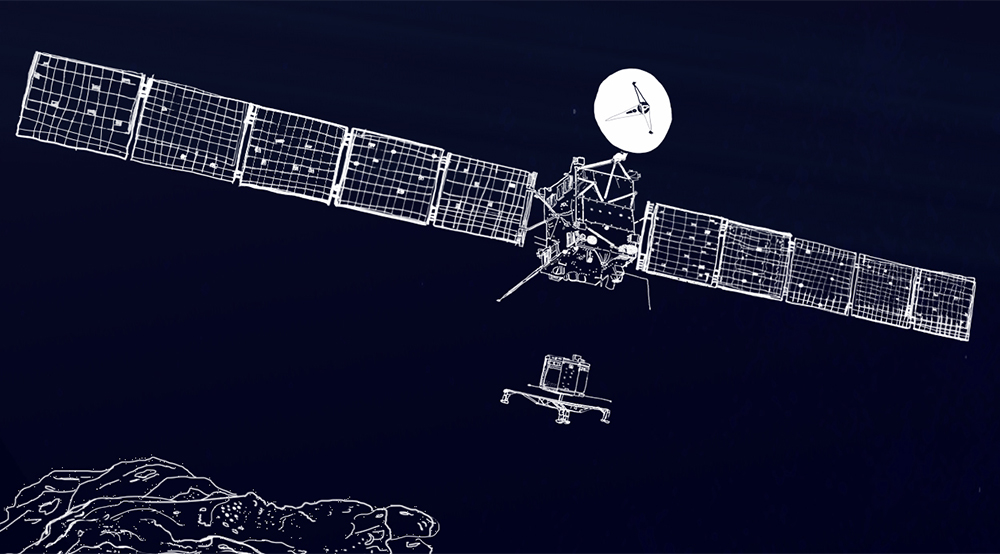
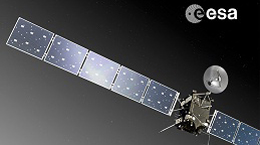
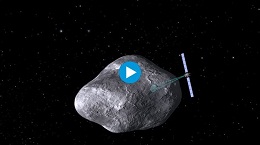
Discussion: 59 comments
Congratulation to finally presenting the most essential data set for this comet. This is very welcome and hopefully updated and complemented as promised. The planetary orbital parameters can be found in Wikipedia for those who wish to follow the comet on the sky with their planetarium software.
Thanks
Thanks a lot, Emily. Bit of late for my midnight train.
Here is my latest Shape-Model. It has a bit more detail than the one released by ESA.
Download it here:
https://mattias.malmer.nu/2014/12/new-shapemodel/
So nice to get essentials, this pleases a lot of the dedicated followers in this blog.
Thank you so much for releasing the 3D model of the comet. I can’t wait to get home and better understand its very unusual shape. Will there be updates to the 3D model with increasing detail in the future?
Thanks again,
Dan
ps Love the outgassing on the recent montage!
Fantastic. Ten years, genius-level engineering and a lotta’ work just to analyze a stupid rock, eh?
ALL ‘rocks’ are stupid…including the one in your head. Go and get a life.
Come on man, look past the obvious. Destiny beckons…we have to start somewhere. ‘WE’ must have started somewhere…are we looking at ourselves? Were we galactic travellers before we ended up on Earth? I like to think so!
Thanks for sharing the model! I noticed there’s substantially more detail on one side of the comet than the other. Do you expect to have higher detail models in the future?
What do the gasses imply about possible surface and subsurface life?
How can there be jets of water if the surface and subsurface are so cold?
Remember, in the vacuum of space, sublimation temperatures are far lower than under a dense atmosphere.
that subsurface temperature is impressively cold, 30 K is minus 243 Celsius / minus 405 Fahrenheit.
The Neptune moon Triton has an average surface temperature of 38 K, Pluto is a little warmer and Eris only a little colder.
Although is it is expected to find some building blocks for life, it not expected to find active lifeforms. Finding dioxygen would be a strong indicator for life, but it is not necessesarily there, even if some active lifeform does exist. Regarding water: remember that substances have a gaseus, a liquid and a solid state. These states depend on temperature and pressure. In empty space, and on the surface of this comet with virtually no atmosphere, the pressure at the surface is too low for liquid water to exist, thus water goes from steam to “snow” without ever entering a liquid phase. You may read the wikipedia entry on the triple point of water: it is basic to the understanding comets!
I correct myself: “steam” is a fog of tiny droplets of liquid water, so no steam is formed on the surface of a comet. Inside the comet higher pressures and higher temperatures may occur, leading to liquid water. Near the surface, ice may sublimate (direct transition from ice to gas – not “steam”) . Now, the coma of the comet is visible, and snow crystals are highly reflective, whereas water in a gaseous state is less reflective, so maybe the coma consists of some watery snow that originates from a liquid state in a higher pressure region within the comet, or maybe the visibility of the coma is due to reflective particles other than water. Someone else will be able to give you a much better explanation, and in a couple of months, the knowledge in this area will have grow a great deal. Then you and I will just have to wait for these discoveries to be published.
@grant strine I, for one am convinced that there is teeming microbial life within the comet. The surface is not ideal, and Philae can only scratch around the surface, but I suspect there will be evidence without plausible alternative explanation.
I thought it would obvious. The jets of water come from the spa[ce] bath of the comet’s caretaker when he gets a bit overzealous and gives the water jets an extra turbo burst to massage and warm his cold body.
The north polar star of Comet 67P/Churyumov-Gerasimenko is the blue supergiant star Alpha Camelopardalis some 6,900 light-years away from our solar system and appears visually at magnitude 4.26.
Alpha Camelopardalis is some 600,000 times more luminous than our Sun, making it one of the most luminous stars known, and is a so called ‘runaway star’ as is travelling at 4,200 KPS / 2,600 MPS or 15.120 million KPH / 9.4 million MPH, or approx. from the Sun to the Earth every ten hours.
Thanks a lot for the 3D files !
Now I will have a 3D printed version of Chury !
Wow !
Got such a rush when the 3d model loaded.
Working on the supports and it goes to print !
Thanks you so much for releasing these magnificent data 🙂
Very interesting. It appears obvious we have two large rocks that managed to hook up and get married with just enough umph to melt them together. I am very disappointed though. I felt Comet 67P should have a alien space settlement located on it that was used for capturing our human TV programs and re-broadcasting them through out the universe. Or, at the very least, a grounded spacecraft with frozen blood sucking monsters waiting for us to visit and take back to earth. 🙂 But lacking those things, it is still a once in a life of the human race event that we should all remember. Still, where are those aliens?????
Thanks again for the info Emily, especially the 3D model. Unlike Mattias I have absolutely no experience with 3D graphs, but inspired by his and the other wonderful images from Rosetta, I purchased an app today . Here are my first couple of attempts using the 3D shape model of the Philae landing site kindly shared on this blog some time ago. I am sorry I can’t remember who, but they suggested we might like to try some different lighting and angles to create our own images. So I did.
https://www.flickr.com/photos/124013840@N06/15432668582/
So just a rough calculation suggests that the gravitational acceleration would be around 1.5mm/sec^2. So simply “dropping” the lander would take a very long time (besides the time-limit of landing and research before the Sun pass-by – about the same time the lander is BBQ’ed). So the lander will need to be propelled down, and I guess “pegs” will have to be “shot” into the surface with some careful calculations will be needed to counter the “peg” shots – taking into account that these may not all be successful in attaching to the surface. This all done without human intervention. Look forward to any comments on this from the team?
Robbie – the gravitational acceleration changes a lot between Philae’s departure from Rosetta at about 20km above the surface and when it actually touches down.
It drops as 1/r2 from the centre of 67P/C-G, and since the comet has a radius of roughly 2km, there’s a large difference in the gravity between 2 and 22km from the centre, roughly (22/2)^2 = 121 times less.
To put it in numbers, a 10 billion tonne comet with a density of 0.4g/cm3 would be equivalent to a spherical (!) object with a radius of 1815 metres.
The gravitational acceleration at the surface of this object would be 0.2 mm/s2, but at 20km “altitude” (22km from the centre of the comet), it’d be only about 1.4 micrometres/s2.
So yes, if just dropped in space at standstill with respect to the landing site, Philae would take quite some time to get to the surface (I’ll leave that to you to calculate 🙂
But in fact, Rosetta will be flying on a trajectory towards the landing site before deploying Philae, so we don’t need (or have) any propulsion system to get down to the site: Philae will be on the way down already.
Shortly after deployment, Rosetta will make a pull-up manoeuvre to avoid the comet and stay in line-of-sight contact with Philae all the way through its descent.
There will be some acceleration due to the comet’s gravity and, combined with the initial velocity, Philae will arrive at the surface at about 1m/s. Given that Philae has a mass of about 100kg, that then results in quite a bit of momentum, similar to that of a fairly burly bloke walking straight into you.
As Philae hits the surface, that momentum becomes a force which pushes the ice screws in the three feet into the comet, and once at least two of the feet have touched down, two harpoons fire into the surface as well.
And you’re right: it’s all done without human intervention. That’s why it’s so challenging 🙂
Humm,
I came personnaly to a rought estimate of escape velocty of 1.65m/s.
I read outburst speed estimate from 5 to 15m/s ?!? Does it mean since the comet is orbiting the sun it looses mass – definitly ?
Assuming the current rate of 5kg/s, simple figure gives me huge 6.3E9kg lost per orbital period – I can’t believe the number over 4.3E9 years.
What do I have interpreted wrong?
I came up with similar sorts of numbers, however we have no idea how long 67P has been in its current orbit or how it has changed over time due to its decreasing mass, gravitational interactions,etc.
The other thing to consider is that water is not the only volatile escaping from the comet and it is clearly losing large amounts of dust too. It could be losing a lot more mass than that. Also that mass loss rate was speculated by the MIRO team to maybe increase by several orders of magnitude as the comet gets closer to the sun. It may be only a few decades before it is all gone. It might be nice to get an estimate at some point as to how long the science team thinks it will take to expire.
doekia: yes, the comet is losing mass. 5kg/s over the period of the orbit will not be reliable way to calculate mass loss, because for much of its orbit the comet is not warm enough to be emitting. On the other hand, near it’s closest approach to the sun it may be emitting considerably more. Either way, you are right that such mass loss would be unsustainable over the lifetime of the solar system, however 67p has likely spent most of its life on an orbit far from the sun, entering its current orbit only recently. As recently as 1959, It’s orbit was changed significantly by an encounter with Jupiter.
Minimum surface temp is -68 C
Maximum surface temp is -43 C
Amazing, while flying in a plane at an altitude of about 35000 feet, we get around -40 to -50 degrees celsius. This comet is millions of miles away from earth and still the temp is not on some extreme side.
My be I am wrong in my calculations!!
Temperatures at the surface are similar to winter temperatures at the surface in Antarctica and certainly -43 centigrade is not that unusual in many countries around the world. The surface, as has already been described, is very, very black, meaning it absorbs light/heat extremely well and little, about 3 – 4% was a rough guess initially, of that heat reflects back into space. As the comet gets closer to the Sun that surface temperature will rise. It will be interesting to see how high it does go and how much of that heat gets transferred into the body of the comet.
Already it looks like the surface may actually go above 0 Centigrade. Liquid water will still be unlikely, but the rate of sublimation of gases may create enough vapour pressure close to the surface for it to happen. Is Phiiae watertight? Would she float? Those harpoons might come in handy. 😉
This comet does not get very close to the Sun, but others, like comet Ison, do. Perhaps Ison just melted and boiled away. Given the huge amount of dust in comet’s tails, one might deduce that a large amount of the surface layer would be expelled by outgassing, revealing the more reflective ices beneath. This would in effect cool the comet surface down, moderating the amount of outgassing. Rosetta plans to measure the activity as 67P approaches the Sun and it may well be the level of activity, although increasing generally, may well show fluctuations in the rate it increases. The activity of comets is notoriously unpredictable and I am sure the depth and nature of the material making up the surface layer has a large part to play in this.
Visually the surface layer of 67P looks to have accumulated over a long period of time, so I’m guessing the rate of sublimation and outgassing never becomes great enough to disperse the surface layers. We see even, dusty looking, “plains” covering the ices and gases underneath. I would expect those areas not covered in dust, exposed cliffs, crater rims, outcrops and icey boulders, to be more likely to begin actively outgassing first, but because there is little surface dust to expel plus any dust embedded in the ices, it is very difficult to see the outgassing. The great number of overhanging surface features would indicate exposed areas are “eroded” more rapidly than those covered by the fluffy blanket of dust and organics we see on the “plains” and crater floors.
The streamers of material we have seen are composed of tiny dust particles and are in fact very diffuse. In the pictures we know the contrast is stretched vastly so that we can see the surface of the comet, yet still the dust is quite faint. As the amount of water vapour around the dust increases, gravitational and electrostatic forces attract water molecules to the dust, just as raindrops form in clouds. Each particle of dust will become coated in ice. The brightness of the streams as a result, should increase along with the activity, at which point the whole coma will brighten and the water vapour already streaming behind the comet will start to become more visible.
Thats what the current theories would suggest anyway, but given the mysterious nature of comets in general, events could show something completely different going on. Thats why this mission and others like Mariner 4, Viking, Voyager, Cassini-Huygens and New Horizons are so exciting. The proving of theories, even educated guesses, will surely be trumped by the unexpected.
How many photographic sessions were conducted with OSIRIS until today and how many images were made during these sessions?
Will Rosetta be flying on a collision course with the comet until the pull-up manoeuvre?
67 PC-G would float on water, if you could find a way to lower it down slow enough.
In every approach to the sun the comet is loosing material.
Judging from the observations until today, and from the shape of the comet, can we conclude that this loss is what caused the neck to form?
If the neck was formed by the loss of material mainly from this area, then the comet was not formed by the fussion of two bodies, but in another way.
If most of the material is lost from the neck, it will seem that after some time the comet will split in two.
At this point of the observations, can we have any estimate of the mass that is being lost in every approach to the sun? How long will it take for the comet to break up in two?
Simulation in Unity of the 3D Model in Space
https://gruvaltec.site90.net/67P/Rosetta.html
Cratering mechanics in icy bodies and planets papers
Planetary scientist Sarah Stewart
https://www.fas.harvard.edu/~planets/sstewart/PublicationsArea.html#formation
The surface appearance of 67P surprised people, myself included. It seems theory, computer modelling and experiment show there could well be plastic flow from low speed impacts and liquids ejected at low angles from porous volatile/rock mixtures. Crater floors are likely to be flat due to compaction and liquid formation, with very steep crater walls.
Thanks for that Morganism. I’m glad I wasn’t totally barking up the wrong tree in a couple of my earlier posts. 🙂
These planetary formation and evolution papers were all published before the Dawn mission to Vesta where the findings suggest planetary scientists need a new, more complex theory to explain formation and evolution.
https://www.sciencedaily.com/releases/2014/07/140716131632.htm
great! thanks so much for sharing; and the hires-pics gives a good mapping-basis for a detailed model. I will post in near future (maybe for the landing) a surprising pice of art with that and I can assure it will be not a 3D-print, but something you havent probably seen yet…
Thanks much for publishing the model!
I was able to 3D print it, and also create a toy augmented reality app for my android phone. (this is just for my own fun, but I’d be glad to send the android app to ESA.)
See images posted in my blog here:
https://robertmcgrath.wordpress.com/2014/10/05/esa-releases-3d-model-of-comet-67pcg-for-home-use/
By the way, following a remark from my spouse: the 3D printed model would be cooler if it were done in chocolate.
ESA – don’t miss this opportunity to create unique treats! Who doesn’t want a box of “67P/Churyumov-Gerasimenko” sweets?
I’m very curious whether there are extremophile organisms on earth that could thrive under the conditions found on Chury.
The peaked carbonated ice mountains and outgassing of different gasses is reason to suggest that the Comet nuclei produce something out of nothing. such as the Big Bang should do.
new physics seems to be needed.
https://bigbang-entanglement.blogspot.nl/2014/10/water-ice-production-of-comet-67p-cg.html
It’s fascinating to read the various geological hypotheses (oops, I almost wrote ‘theories’) in this and other comment threads. And now biological hypotheses. So I thought I would add my own. This comet is a big bottle of Champagne that has been shaken up by impacts in the past and by the moving gravitational field exerted by Rosetta itself. The cork is coming loose and the contents are starting to spray out, forming jets. The biggest threat to Philae will be intoxication as it absorbs some of the fumes on its way down.
Is there a prize for this?
Thanks for the model! I tweeted a rubber duck version here: https://twitter.com/chrfrde/status/519282847513710592
🙂
Comet CG has very low albedo, reflecting a carbonaceous regolith. The plain, which curves around the ‘neck’ is surprisingly smooth, indicating an underlying ice sheet, which must be young as it’s not been pitted by meteorite impacts. We interpret it in the context of our earlier study of Tempel-1, Borrelly, West and Hartley-2 **. The plain is covered by sublimation regolith of order 10-cm thick, with strength of a cold-welded carbonaceous crust. Look at the boulders standing proud (up to 70m in size, better seen on small scale images), not eroded from any cliff. Dirty ice-boulders develop dark protective sublimation crusts so have a long lifetime on CG’s distant orbit. We surmise these are ejecta generated by a large meteorite impacting compact frozen terrain elsewhere on the comet. Most of the surface would be too weak to allow them to stand proud – where they stand indicates stronger refrozen terrain.
** Wallis & Wickramasinghe: ISSOL conf. Origins 2011 P7-21 Icy Morphologies of Comet Tempel-1 imply past lake-habitats for Life http://www.astrobiocymru.com/2011_09_01_archive.html
The model was uploaded to Sketchfab, a cool way to look at 67P/C-G in real-time 3D on the web 🙂 https://sketchfab.com/models/166649180f874892bb59906cf4c42685
Time for an official ESA account?
Thanks for the 3D model. Rosetta was launched during the time I was working for Astrium, the space division of Airbus. Today I am an indie video game developper and I could not resist to I add the model in the biker game I am currently working on. You can have a look here:
https://wild.game.blog.free.fr/index.php?post/2014/10/08/Nod-to-my-former-colleagues-of-AIRBUS-ASTRIUM.
By the way, the game can be downloaded for free here https://wild.game.free.fr 50% of benefits are given to research against cancer.
Thanks for the model !
What is the unit of length in the VRML model? I had to multiply by three to get plausible values in kilometers.
Thank you so much for the model!! I did a quick animation render of a fly-by. I added a sand/soil texture that looks more like the photographs we’ve seen. Ironically, I initially used stone as the texture and it didn’t look right!
Here is a link to the animation:
https://www.dropbox.com/s/lxmljhu4o66oq4t/Comet%2067PChuryumov%E2%80%93Gerasimenko-SandSoil-Texture.avi?dl=0
I’ve downloaded the .wrl file, but there’s little info in the header to say what the fields contain. Since many of the numbers come in groups of 3, I’m guessing that some of these may be x,y,z coordinates. Can someone point me to a description of .wrl fields?
What are the chances of a breakup and one or multiple pieces be headed toward Earth?
the low gravity may mean 67p is a loose pile of debris,not solid so no pressurised gas
Would be interesting to see Philae analysing soil samples and sending pictures from microscope. I hope that it will still happen!!
Does anyone know how to determine the axial tilt or obliquity of an object in space, given that we know its orbital inclination, and its declination for the spin axis? My guess is that in the case of Comet 67P with a declination (D) of 64°, knowing its orbital inclination of 7.04°, we subtract that number and the earth’s axial tilt of 23.4° from D, which produces 33.6° as the obliquity of Comet 67P. Is that correct?
I noticed that a similar subtraction would yield the previous estimate of 40° for the axial tilt of 67P, when it was thought to have values of RA = 40° ± 10°, Dec = 70° ± 10° *Ref= “Spin and activity of comet 67P/Churyumov-Gerasimenko” — J.-B. Vincent, L. M. Lara, G. P. Tozzi, Z.-Y. Lin, and H. Sierks (2013).
I’m not sure, how the estimate of 40° was obtained, but the above subtraction may explain it. ESA has reported 40° as the tilt for the comet, on their information page about the comet. >> https://sci.esa.int/rosetta/14615-comet-67p/ <<.
I looked at this paper — “Shape and obliquity effects on the thermal evolution of the Rosetta target
67P/Churyumov–Gerasimenko cometary nucleus”.
M.C. De Sanctis et al. Icarus 207 (2010) 341–358. — it describes the findings by Chesley from 2004, about the spin axis of Comet 67P, including the two variables I = obliquity = 43°, φ = 236° (azimuthal angle, equivalent to RA). How Chesley obtained these values, I do not know, since I do not have access to his original publication in BAAS.
Well, I answered my own question, after reading this paper:
A&A 444, 605-614 (2005)
Thermal evolution model of 67P/Churyumov-Gerasimenko, the new Rosetta target. M. C. De Sanctis – M. T. Capria – A. Coradini
In the Introduction they say, “Recently, Chesley & Yeomans (2005) estimated the pole of 67P/Churyumov-Gerasimenko, using the non-gravitational acceleration method. They found a pole position RA = 90° and Dec = 75° with an obliquity of about 43°.” — So that’s how they got the obliquity for 67P. Now it makes sense.
My subtraction method above was not the correct solution to this problem. I was just grasping at straws, as I thought they were using the declination to make the determination.
There are probably some complex equations involved. 🙂
Also, we must consider that the orientation of the orbital plane of Comet 67P is different than earth’s equatorial plane, so that the angle of tilt for earth’s axis (from the perpendicular to the ecliptic) will not be exactly 23.4° ± 7.04° relative to the orbital plane of Comet 67P. Some form of calculus is required to determine this number (adjusting for earth’s tilt and the inclination of the orbital plane for the comet, when RA=69°, and D=64° — equatorial coordinates). The obliquity of the comet will then be its axial tilt from the perpendicular, relative to its own orbital plane. The value of the ascending node of its orbit is 50°.
I have derived the equation 64° – (2/9 x 7.04°) – (5/9 x 23.4°) = 40° for the obliquity of Comet 67P. The factor 2/9 is obtained from (90 – 69)/90 (for RA=69°), while 5/9 is from the ascending node of the comet relative to earth’s degrees of orientation for its own axis (50/90).
Hence, we see the statement at the Rosetta Blog , “recent observations suggest that the axis is tilted about 40 degrees.” 🙂
Correction: 64° – (2/9 x 7.04°) – (5/9 x 23.4°) = 50°, for the declination angle relative to the orbital plane of the comet. The obliquity is then the difference of this number from the perpendicular, i.e. 90° – 50° = 40° << axial tilt.
I had skipped a step.
My equation above is just an attempt to arrive at an obliquity with the given information that I had available. The real solution is probably more complicated than that, as the comet’s orbital plane (oriented to 7.04° above the ecliptic), and the equatorial plane (oriented to 23.4° above the ecliptic) are pointing in different directions.
The angle formed between the comet’s axis and earth’s axis may also come into play when subtracting from the declination to obtain the angle of the comet’s spin axis with its own orbital plane. Unfortunately, I have not seen any detailed explanation of what equations are used to derive this value.
Maybe it’s a trade secret. 🙂
Awesome you’re sharing a 3D model of that rock! What’s the scale used in those files, i.e. how large is one unit?
Thanks for posting up this data. This seems to be one of the only sources of quality data release to the public. Please keep up the good work, we are hungry for more information.
Hi, Are there any updates on these figures? I’m intrigued by the density being 0.4 g/cm3, but it sounds like this may have been estimated on the mass measured from quite some distance. Is there an updated mass figure as Rosetta got nearer the comet that would shift the density given above? Or is this density figure our most recent and up-to-date estimate?
Thanks.